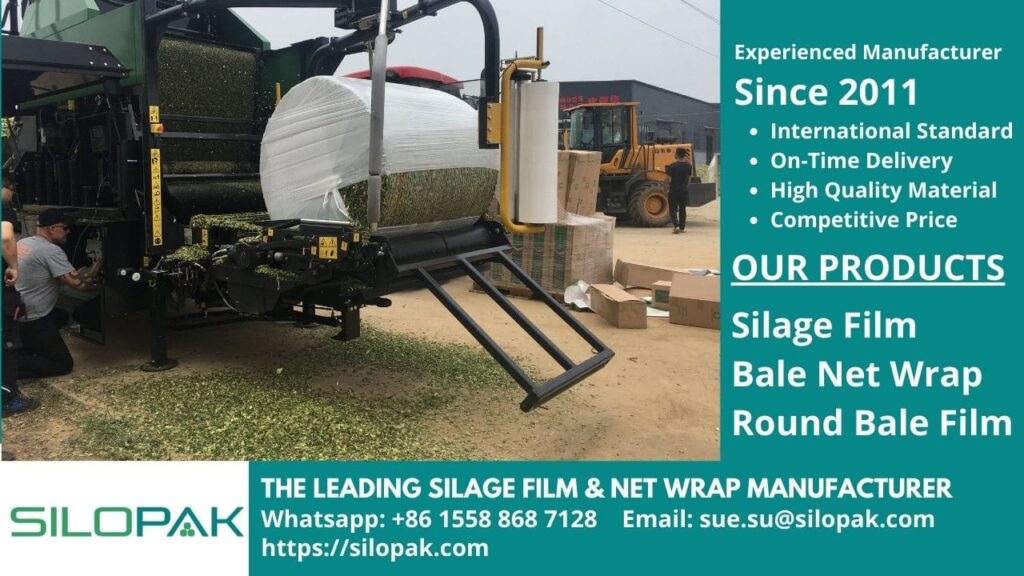
Silage has a very good nutritional content of the animal feed. Grass bales can rot quickly if not handled properly. Therefore, you can wrap them into grass silage bales. Wrapped bales do not turn into silage immediately but require time for the fermentation process.
Silage can be made with production grasses with higher protein and fructan content, Dry Matter percentage between 35% to 45%, and ensuring sufficient acidity and less stress. This method aims to maintain nutritional value. In making good silage, it is necessary to pay attention to several factors, including; mowing time, mowing size, moisture content, dry matter content (DM), baling, and packaging process.
Lawn Mowing Time
The timing of the mowing will have a significant impact on the yield and quality of silage. Cut the grass immediately when harvesting begins. This is to improve and produce an increase in silage quality. On the other hand, the quality of the siamese will decrease as the grass begins to produce stems and heads.
This is because the condition of grass that has grown up is less easily digested by the digestive system of livestock than grass that is still in the leaf growth phase. The selection of the optimal cutting time is influenced by the grade of silage stock to be fed. You can analyze fresh grass to determine the content of nitrate N and crude protein.
However, you may not be able to use sugar analysis to determine cutting times because these conditions change from hour to hour or day to day, depending on the weather conditions.
Grass Cutting Length
Mowing the grass as it is picked can produce more efficient silage because it ferments well. The cause is the release of more sugar content, and the trapped oxygen is dispersed. This makes it easier for the chopped ingredients to consolidate in tongs and make the bales denser, with weight gains ranging from 8 to 12 percent. Those of you who have livestock can consider grass silage bales.
For making silage that requires bale net wrap or round bale film, you can use our product. Of course, only the highest quality products we offer. Eliminate your doubts because we are the best silage film manufacturer that uses premium resin. You can use our products in any weather. See what other people think of us, how their stories about our products are what makes us continue to strive to provide the best products.
Our products have been used in various countries. We are Silopak, we have been exporting our products since 2011. You can also get silage film for your animal feed needs. Use bale net wrap, silage film, or round bale film to maintain the nutritional content of the animal feed.
Moisture Content
Allowing grass or plants to wilt will reduce moisture content and reduce seepage. The DM (Dry Matter) target that must be considered for clamp silage is 28 percent to 32 percent, and for silage bales, it is around 35 percent to 45 percent. Rapidly wilting plants or grasses are possible to keep losses to a minimum in the field and promote better silage preservation. The long wilting process allows for drier mater loss in the field, and this can increase the chances of aerobic spoilage in the feed out. Here are some things to do when silage is in the field:
- Cut the grass after the dew dries. When in these conditions, the plant contains a higher sugar content. The rapid wilting process will concentrate the sugar, allowing for faster and more effective fermentation.
- The conditioner on the lawnmower will split the grass, so there is a larger surface area for removing water. This condition can increase the rate of wilting of plants by up to 20 percent.
- Leave the stump (at least 5 cm) to allow air movement under the spreading grass.
- Spread the crop quickly and widely because two hours after cutting is the decisive factor in removing water.
- Make sure the rake and tedder are installed at the right height so that they can work more efficiently.
- Maximize plant wilting as quickly as possible within 24 hours. Plants with high numbers may wilt within 48 hours.
- Line up into a grid in the form of a box before the propeller. You need to consider grass silage bales.
Baling
In the propeller, some things to note are as follows:
- Make sure the baler is well maintained. Aim for denser bales to produce heavier bales. This reduces baling and wrapping costs.
- Clean the rollers regularly for the Spherical Baler; the aim is to avoid material build-up.
- Use net wrap that also covers the edges of the bale by 2cm to 5cm to help remove lumps to reduce the amount of trapped oxygen.
- Check soil conditions and adjust embankments to prevent soil contamination.
Silage Wrapping
In wrapping silage, make sure the wrapper is well maintained. If the bales are field wrapped, transfer them to storage immediately to prevent interrupting the ongoing fermentation process. The oxygen that enters during the fermentation process can cause moldy silage. Use high-quality film with UV protection to ensure the quality of the silage.
